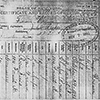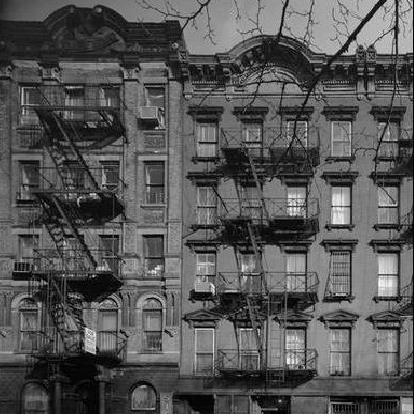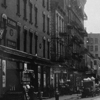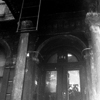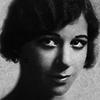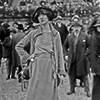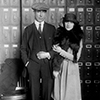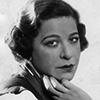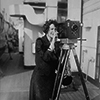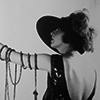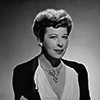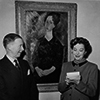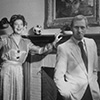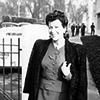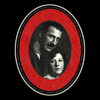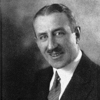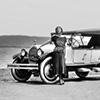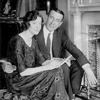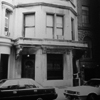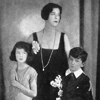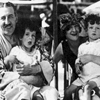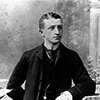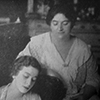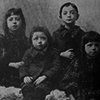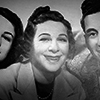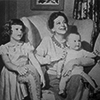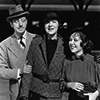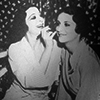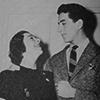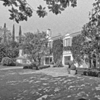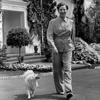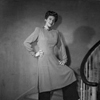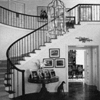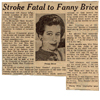Fanny Brice
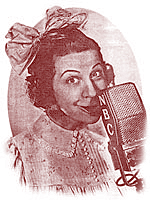
"Turn on the radio
and listen to Baby Snooks."
"Why?"
"Because!"
Baby Snooks was the ever asking little girl which Fanny played in radio acts in the late fourties. This was long after she wàs a little girl, 13 years of age and named Fanny Borach, on stage at the Keeney's. Borach was her real name, which she changed to Brice as she grew more famous in the vaudeville and burlesque-shows.
Fanny, a daughter of Jewish immigrants was born on 29 October 1891, New York East Side. She grew up in Newark and Bergenstreet/St. Mark's Avenue in Brooklyn. As toddler, she drew attention to herself, singing and dancing on the billiard-table in the free lunch saloon bar of her parents.
Her first stage performance was in Frank Keeney's theater on Fultonstreet in Brooklyn. This was probably on 16 january 1906. On tuesday nights he organized performances for amateurs. On that same Keeney stage, Al Jolson brought his first blackface act in 1904. Fanny won, by singing the coonsong When you know you're not forgotten by the girl you can't forget, the first price of 10 dollars. That night she got involved with the theater public.
In 1910, 18 years of age, Fanny performed in Max Siegel's Collage Girl burlesque-show for 25 dollars a week. Irving Berlin gave her the Irish song Sadie Salome for that show. Before that time, she never sang with an accent and she would be an Irish comedian the rest of her life, had Irving not sang to her that song with a Jewish accent instead of an Irish accent. Now she was sadie, a Jewish comedian, according to Fanny. This performance made Florenz Ziegfeld, the revue king of Broadway, to contract Fanny for his 1910 Follies. This time for a wage of 75 dollars a week. She was to become Broadway's highest earning star.
Trixie Wilson, a theatre colleague, told:
"She was the biggest. You could not have seen Fanny Brice on the stage and forgotten her, not as long as you lived. "
Stanley Green in his book The Great Clowns Of Broadway:
"On stage she was prone to the most outlandish outbursts and facial expressions as she distorted her remarkably mobile features into a variety of comic grimaces. With little apparent motivation other than an irresistible urge to cut up, she would cross her legs, puff out her cheeks, slap her forehead, buckle her knees, and collapse her long, slim body. And even when she wasn't milking a laugh, there was always something ludicrous about the comedienne's glinting, mischievous eyes and wide, half-moon smile that gave her the appearance of a canary-swallowing cat."
Or, as director George Cukor told to writer Norman Katkov:
"She had this extraordinary smile (...) so that if you were in the audience you knew the smile was directed at you and at you only and that she had never smiled at anyone before. She would come out smile, and wait until she had willed the audience to be hers."
And Fanny about herself once when she was asked about her career:
"Listen, kid! I've done everything in the theatre except marry a property man. I've been a soubrette in burlesque and I've accompanied stereopticon slides. I've acted for Belasco and I've laid 'em out in the rows at the Palace. I've doubled as an alligator, I've worked for the Shuberts; and I've been joined to Billy Rose in the holy bonds. I've painted the house boards and I've sold tickets and I've been fired by George M. Cohan. I've played in London before the king and in Oil City before miners with lanterns in their caps."
The name Fanny Brice is closely connected to Florenz Ziegfeld, and the name of Florenz Ziegfeld with that of Fanny Brice. After the great successes of the Follies, Ziegfeld asked her "Do you think you can make them cry?" With that he handed her the song My Man, which was translated from the French Mon Homme, to sing in the 1921 Follies. She sang it gently, night after night in the same way, with her eyes closed, and every time it was as if Nick was with her. Nick Arnstein, her husband, to whom she married in 1918, was the mastermind of a 5 million dollars, questionable Wallstreet stock deal. In February 1920 this was frontpage news, called The Mastermind Case. Nick got sentenced to 2 years inprissonment. Although Nick, gentleman and gambler, was still the man of her dreams, Fanny started to loose control over him. This, and the fact of Fanny's love for the theater that stood between them, eventually caused them to divorce.
Two years after her divorce she met and fell in love with Billy Rose, a combination which made everybody wondering. Themselves not the least. We like each other very much, we have got the same ambition, and that is making theatre, and Billy writes great songs. They got married in February 1929. But a songwriter was of no account in the society to which Fanny belonged, and Billy soon was known as mister Brice. "If you want to have your name back," said Billy to himself, "you will have to become a producer." This resulted in the Broadway hits Sweet and Low and Crazy Quilt, created by both of them.
Another big hit for Fanny was the creation of Baby Snooks. This character was based on an ever "why" asking little daughter, and performed by Fanny in the 1934 and 1936 Follies. Baby Snooks was also to be seen as a comic act together with Judy Garland in the 1928 film Everybody Sing. Until the very end of her life she performed Baby Snooks weekly on radio, together with Hanley Stafford as Daddy.
Fanny Brice died 29 May 1951 in Beverly Hills, California.
Related links
- Fanny Brice Dies at the Age of 59 (The New York Times obituary)
- Fanny Brice's grave (photo)
